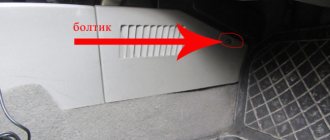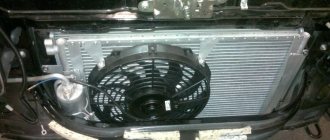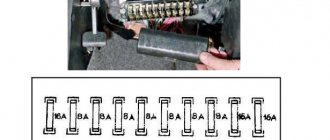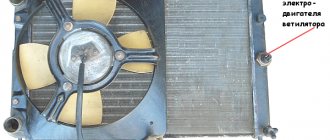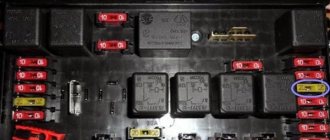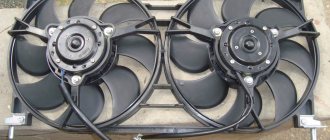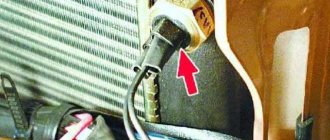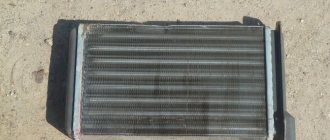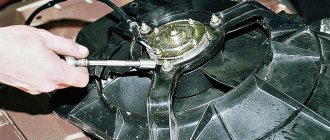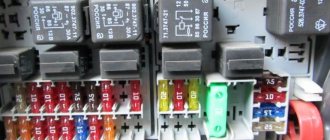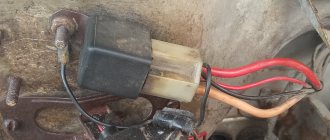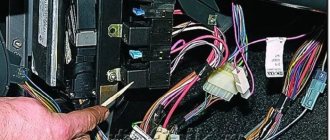A possible reason for your power windows, cigarette lighter, or other electrical device not working may be a blown fuse or broken relay.
Below - about fuses and relays on the LADA Kalina (station wagon, hatchback) of the 2nd generation: where they are, how the circuits are deciphered and how to replace them yourself.
Where is the fan relay located?
To access it, follow this algorithm:
- On the interior side, we find a bolt located at the left leg of the front passenger, on the side of the center console. We unscrew it, after which it will be possible to dismantle the decorative trim.
We unscrew the bolt and gain access to the relay.
Varieties
- Where there is one relay and one cooling fan speed.
One fan relay in the diagram.
Block on LUX
This is what the additional relay block looks like on the Luxury version of the Lada Kalina.
Where is the radiator cooling fan relay located on Lada Kalina?
Car : Lada Kalina. Asks : Abramov Sergey. The essence of the question : the radiator cooling fan is not working, the fault is with the fan relay, where is it?
Hello, my radiator cooling fan has stopped turning on. I think the relay has failed, but I don't know exactly where it is located. Please tell me!
Cooling system malfunctions
First of all, this is due to antifreeze leakage. This malfunction is clearly visible under the hood of the car. In most cases, fluid leakage from the system occurs due to:
- lack of tightness on the pipes.
- clamps are outdated;
- the heating radiator is clogged;
- The cooling radiator is broken.
The heating radiator will have to be replaced, but a large radiator can be repaired. You just need to solder the holes. But it must be remembered that it is mainly the copper radiator that is soldered. The aluminum radiator installed on Kalina is rarely repaired. It is better to immediately replace it with a new one.
In case of constant overheating of the car engine, the first place is due to malfunctions of the cooling system:
- Thermostat. To check it, you need to warm up the engine. Use your hand to touch the pipes leading to the radiator. When the top pipe is completely cold, while the bottom pipe is slightly warm, we can talk about the thermostat being stuck. In this case, the liquid moves in a small circle. There is only one way to fix the problem - you need to install a new thermostat.
- The radiator honeycombs are completely closed. A common cause of abnormal operation of the cooling system. In most cases, this happens at the beginning of summer, when poplar fluff begins to fly. To get everything back to normal, you need to clean the outside of the radiator. Sometimes such work causes certain difficulties, but this is the only way to make the system work properly. You have to do manual work.
- The fan is broken. When the heating temperature exceeds 95 degrees and the fan is silent, several parts need to be checked:
- cooling fan relay;
- electrical wiring;
- sensor
After detecting problems, a new relay and sensor are installed, and the wires are replaced.
Or maybe it's not the fan relay?
In order to accurately determine the cause of such a malfunction, it is necessary first of all to check all fan contacts for the presence of oxides and traces of rust, as well as the wiring for breaks and abrasions.
Fan relay and fuse, where are they?
The additional fuse box is marked with an arrow in the photo.
If these manipulations did not bring any success, then it is necessary to look at the fuse and relay responsible for the operation of the cooling fan.
- Finding them is not difficult; you just need to unscrew one bolt located on the side of the center console near the left foot of the front passenger.
- When the decorative trim is dismantled, we will need a “10” key to remove the fuse box from its place of fixation and bring it out.
- This work may cause some inconvenience, because thick wire harnesses are connected to the relay block.
- This is how it looks after removal, now all that remains is to check their functionality and put everything back in the reverse order.
When they are dismantled from their place, you can easily carry out work on them.
- Low speed cooling fan relay.
- Main relay.
- High speed cooling fan relay.
- 50 Amp fuse.
- Relay for turning on the pump (fuel).
Source
Causes and symptoms of fan malfunctions
To understand that the electric fan is faulty, you don’t need complex diagnostics - any car enthusiast can do it. You should start the engine and let it idle until the coolant temperature reaches a critical temperature. You can monitor the process using the temperature sensor on the instrument panel. When the arrow is close to the red zone, the sensor should give a signal to the controller, which will start the fan. You can recognize this by the characteristic noise coming from the engine compartment. If the indicator shows a critical temperature, and the fan does not start working, then there is a malfunction that needs to be corrected immediately. The fan may not work for a number of reasons:
- The electric motor is faulty. In this case, it will not rotate the impeller. Typically, on VAZ cars, the electric motor rarely fails. To check its functionality, you will need to connect it to the battery directly. To do this, you need to take two wires and connect their ends to the battery terminals and the electric fan wire block. If in this case the impeller does not rotate, then there is a malfunction of the electric motor. This part rarely requires repair. You will need to remove the assembly and replace the electric motor. The work is simple and can be done even outdoors with your own hands with a minimal set of tools.
- The temperature sensor is faulty. If the sensor fails, it cannot track the increase in coolant temperature; accordingly, the controller receives incorrect readings and the fan does not turn on when needed. To diagnose this problem, you will need to disconnect the wire plug from the sensor and short the two terminals together. If the fan operates and the impeller starts to rotate, the sensor is faulty and needs to be replaced. The procedure is complicated by the need to drain the coolant, but it is not so complicated that this problem should be addressed to a service center.
- No tension. The most common malfunction associated with an electric fan is a break in the electrical circuit in one of the sections and a lack of voltage. For diagnostics, you need to “ring” the electrical wiring and check the fuses; to work, you will need a tester (multimeter). If you do not have the skills to use a multimeter, it is advisable to contact an auto electrician.
A problem with the electric fan is also possible in another situation, when the impeller rotates constantly and the electric motor does not turn off. The electric fan may always work or start working too early, when the coolant temperature has not yet even reached operating parameters.
- The relay contacts are stuck. Sometimes situations may arise when the fan relay contacts are constantly in the “on” position, which is why the fan will start immediately after the engine starts. The relay should be replaced and tested for functionality.
- The temperature sensor is faulty. The sensor transmits elevated temperature readings to the electronic engine control unit, which causes the controller to send a signal to turn on forced cooling. Will need replacement.
- Thermostat malfunction. The cooling fan on Kalina is not equipped with an auxiliary temperature monitoring sensor. This means that only average indicators are taken into account. If the thermostat valve is stuck in the closed position, the coolant circulates only through the small circuit and cannot flow into the large circuit. The antifreeze heats up quickly and the electric fan starts to turn on very often. In this case, the liquid does not pass into a large circle, that is, there is no hot antifreeze in the radiator, the fan cools the cold radiator, and the liquid continues to heat up, which leads to overheating of the engine. The thermostat may also jam in the middle position when the valve does not open completely. This also leads to ineffective cooling - the fan will run constantly due to the fact that the antifreeze cannot cool enough. In these cases, you will need to replace the faulty thermostat; this is easy to do yourself. If you need to save time, you can entrust this procedure to the service. Replacing cooling system components is not a complex task and can easily be done independently. An exception is the replacement of the water pump, since it has a single drive with the gas distribution mechanism.
Constant operation of an electric fan is not as bad as if it did not work at all, unless the problem is related to a faulty thermostat, as it can lead to overheating and failure of the power plant.
Cooling fan fuse for Lada Kalina
The fan is necessary for forced cooling of the antifreeze in the radiator in case of excessive engine heating. In the summer, turning on the fan is a common occurrence, and its failure can lead to boiling of the coolant .
While driving, there is a natural flow of air around the radiator. The fan is activated based on the temperature sensor readings. Thus, if the fan does not turn on, then the fault is either the sensor or the fuse.
On the Lada Kalina, the fan circuit is protected by both a fuse and a relay.
Replacing relays and fuses
These protective and fan control components are fairly easy to replace. We remove the burnt element from the mounting socket and install a new analogue. It is convenient to use suitable tweezers here.
Steering rack Kalina
How to drain antifreeze from Kalina
Adjusting the Kalina generator belt
Where to find the cooling fan fuse
The fuse is located in an additional mounting block in the passenger compartment. The place is not very convenient. We specifically took out the block and took a photo.
It is located to the right of the instrument panel, near the air duct. To open you need:
- Unscrew the corner screw from the decorative (protective) trim, then open the cover and put it aside.
The self-tapping screw is marked with a circle.
The main difficulty is that you need to protect the wiring and carefully remove the block.
One fan relay in the diagram.
Cooling fan fuse diagram.
Articles
If after inspecting and replacing the fuse the problem is not solved, you will probably have to change the relay or the fan itself by purchasing an electric motor with an impeller. Before choosing, be sure to find out the original number, which happens:
- 1118-1308008;
- 1118-1300025;
- 21230-1300025-00;
- 2123-1300025 (for 2 motors).
There are analogues of no worse quality, but from other manufacturers.
Lada Kalina - fuse and relay blocks
Lada Kalina 1
The first generation was produced in 2004, 2005, 2006, 2007, 2008, 2009, 2010, 2011, 2012 and 2013 under the internal serial numbers
VAZ-1117, VAZ-1118, VAZ-1119
with sedan, hatchback, and station wagon bodies. In this article we will show a description of fuses and relays of the 1st generation Lada Kalina with block diagrams and photographs. Note the fuse responsible for the cigarette lighter.
The design of the blocks and the purpose of the elements in them may differ from those presented and depend on the year of manufacture and level of equipment of your Lada Kalina. Check the description with yours, printed on the back of the protective cover, or other technical documentation.
Main block
The main block with fuses and relays is located under the instrument panel on the driver's side, behind the protective cover.
Scheme Option 1
Scheme Option 2
Description of fuses
p, blockquote 10,0,0,0,0 —>
| F1 | 15A Electronic engine control unit, cooling fan relay, fuel injectors |
| F2 | 30A Electric windows |
| F3 | 15A Hazard alarm |
| F4 | 20A Windshield wiper, airbag |
| F5 | 25A Heater (viburnum heater fuse), Electric power steering control unit, Windshield washer |
| F6 | 20A Horn |
| F7 | 10A LCD instrument cluster indicator, Brake light switch and lamps, Interior lighting |
| F8 | 20A Heated rear window |
| F9 | 5A Side light bulbs on the right side, Glove box light bulb |
| F10 | 5A Side light bulbs on the left side, Outside lighting indicator in the instrument cluster, License plate light bulbs |
| F11 | 7.55A Rear fog light, Immobilizer control unit |
| F12 | 7.5A Low beam lamp right block - headlights |
| F13 | 7.5A Low beam lamp left block - headlights |
| F14 | 10A High beam lamp right block - headlights |
| F15 | 10A High beam lamp left block - headlights |
| F16 | 10A Right fog lamp |
| F17 | 10A Left fog lamp |
| F18 | 20A Heated front seats, cigarette lighter |
| F19 | 10A ABS |
| F20 | 15A Cigarette lighter , luggage compartment lock, diagnostic connector |
| F21 | 10A Transmission reverse lock circuit |
| F22 | 15A Security alarm control unit |
| F23 | 10A Electric power steering control unit |
| F24 | 7.5A Air conditioner |
| F25 | 10A Interior lighting, brake lights |
| F26 | 25A ABS |
| F27 | Spare |
| F28 | Spare |
| F29 | Spare |
| F30 | Spare |
| F31 | 50A Electric power steering |
| F32 | 30A ABS |
Fuse number 20 at 15A is responsible for the cigarette lighter.
Relay purpose
p, blockquote 12,1,0,0,0 —>
| K1 | Headlight washer relay |
| K2 | Power window relay |
| K3 | Additional starter relay |
| K4 | Ignition switch unloading relay |
| K5 | Alarm relay |
| K6 | Heated Seat Relay / Wiper Relay |
| K7 | High beam relay |
| K8 | Horn relay |
| K9 | Fog light relay |
| K10 | Relay for heated rear window and exterior mirrors |
| K11 | Seat heating relay |
| K12 | Fuel pump relay |
| K13 | Reverse light relay |
| K14 | Radiator cooling fan relay |
| K15 | Heated windshield relay |
| K16 | Heated windshield relay |
| K17 | A/C compressor clutch relay |
Block under the hood
It is located next to the battery.
Photo - diagram
Purpose
- 30A Low beam headlights or main relay, circuits protected by fuses F1 and F21 of the mounting block in the passenger compartment 50A Windshield heater
- 60A Generator
- 60A Generator
- 30/40A Heater fan (heater fuse grants)
- 50A Electromechanical power steering
- 60A ABS block
Engine control unit
This unit is located in the center console.
The fuses responsible for engine operation are located on top under the protective cover.
Photo - diagram
Designation
p, blockquote 17,0,0,0,0 —>
- Diagnostic connector
- 15A - Main relay circuits (winding of the cooling system electric fan relay, canister purge valve, air flow sensor, speed sensor, oxygen concentration sensor, ignition coil)
- 15A - Fuel pump, viburnum fuel pump fuse.
- 15A - Constant power supply circuits of the controller (ECU)
The relays are located in the lower right part of the console, where the fuses for the electric cooling fan are also attached.
The diagrams do not fit or you own a different generation of the model, study this description for the Lada Kalina 2.
We have also prepared video material on this material on our channel. Come in and subscribe.
p, blockquote 24,0,0,0,0 —> p, blockquote 25,0,0,0,1 —>
And if you have any questions, write them in the comments.
Source
Replacing the SOD fan
Replacing a cooling fan is not the most difficult procedure; the first stage involves preparing the necessary tools:
- 10 mm socket head with wrench;
- wrench (socket or socket) 8 mm;
- figured screwdriver;
- pliers.
The replacement process is as follows:
- To make it easier to dismantle the unit, remove the air filter housing by unscrewing the two mounting bolts.
- Using pliers, disconnect the plastic latch of the expander hose.
- Disconnect the wire connector from the mass air flow sensor (mass air flow sensor) by pressing the latch from below.
- Disconnect the wire connector from the canister purge valve on the air filter box.
- Remove the pipe clamp and move it to the side.
- Unscrew the 4 mounting bolts and remove the housing cover.
- Remove the adsorber by pulling it up.
- Unscrew the air intake mounting nut (near the radiator at the top).
- Remove the rubber cushion near the battery and remove the air filter housing.
- Unscrew the two fastening nuts with a 10 mm wrench on the right side, and then unscrew the two nuts with an 8 mm wrench on the left.
- Disconnect the wire plug from the electric fan.
- Remove the electric fan assembly by moving it to the left.
If the node changes, the procedure is repeated in reverse order. To replace the electric motor, you will need to dismantle it. This is easy to do by unscrewing the three mounting bolts with a 10 mm wrench. On the other hand, you need to disconnect the metal latch and remove the motor with the impeller.
Differences in electronics of Lada Kalina 1 from Kalina 2
These two cars, despite their external similarities and common base, have different electrical wiring structures.
The second generation used Renault's developments, which explains the appearance of a body electronics unit, like on the Lada Vesta. In addition, these cars received completely different mounting blocks and their location.
The difference in the mounting blocks is also explained by the appearance on the Lada Kalina 2 of an automatic transmission, climate control and heated windshield. In addition, almost all trim levels now have DRLs. Therefore, diagnosing faults related to blown fuses on these machines is carried out differently.
Where are the fuses and relays located?
Depending on the generation of the car, the fuse blocks have differences, and, consequently, different installation locations.
Location of fuse and relay blocks on Lada Kalina 1
The first generation Kalinas were equipped with several fuse blocks at once. Their location has several places and they are all in the cabin:
- The main unit is located under the panel, to the left of the steering column.
- Another block was mounted under the cigarette lighter, next to the gearshift lever.
- Another mounting block is located under the dashboard, inside the central tunnel.
Where are the mounting blocks located in Lada Kalina 2
The second generation Lada Kalina has two fuse blocks. The main one is located inside the cabin, and in some trim levels it is also installed under the hood.
- One is located in the cabin, to the left of the steering column, under the cover.
- The additional fuse box is located in the engine compartment, to the right of the battery.
It is worth considering the location of the mounting block to avoid mistakes in diagnosing the car.
Correct selection and replacement of fuses on Kalina
The fuse in a car is a plastic product with two contacts, inside of which there is a fuse link.
Different fuses are designed for different current values and if this parameter is exceeded, the insert burns out. It is very important to install the same one in place of the required fuse and not make a mistake.
For example, if a 15 Ampere fuse is installed on the cigarette lighter, then it is no longer possible to install a 60 Ampere or 5 Ampere insert.
The fact is that with a high operating current, the device can burn out or melt the wiring in the event of a malfunction. And with a high current of 15 Amps, a 5 Ampere fuse may blow immediately after turning on the device, since it is not designed for such work.
Fuse links differ in color and amperage. Currently, the following colors and fuses are used in cars:
| Color | Clearly | Operating current |
| Brown-yellow | 5A | |
| Brown | 7.5A | |
| Red | 10A | |
| Blue | 15A | |
| Yellow | 20A | |
| White | 25A | |
| Green | 30A | |
| Orange | 40A | |
| Red | 50A | |
| Blue | 60A |
Lada Kalina cars of the 1st and 2nd generations use blade fuses of the Norma and Maxi standards. The latter are used on Kalina 2 in the engine compartment and several of them are used on Lada Kalina 1 in the cabin.
To replace fuses, there is a special puller in the main unit, which is located in the lower right corner.
Repair and replacement of coolant temperature sensor on Lada Priora
The coolant temperature sensor (CTS) in a Priora car performs the function of monitoring the thermal state of the power unit. Thanks to DTOZH, the driver always knows to what temperature the engine is warmed up and whether there is overheating in the system. You can learn more about the principle of operation, as well as replacing the controller, from this material.
Characteristics and features of DTOZH on Priora
Many motorists confuse the DTOZH with a cabin or ambient temperature sensor, but this is completely wrong. The purpose of the DTOZH is to monitor the temperature of the refrigerant in the cooling system.
There are two regulators in Lada Priora cars:
- One of them is installed on the cylinder head and its purpose is to display information about the engine temperature on the dashboard. Essentially, this is a pointer.
- The thermostat housing contains the DTOZH, which plays a more important role. This device transmits pulses to the control unit to activate the ventilation device. In addition, it plays an important role in the formation of the combustible mixture during startup of the power unit.
As for the principle of operation, it is as follows. The main regulator is located in the thermostat housing, which allows for the highest pulse accuracy. Since the DTOZH in any case comes into contact with consumables, that is, antifreeze, it instantly detects changes in temperature and sends corresponding signals to the ECU. The latter, based on the information received, adjusts the operation of the engine and changes the composition of the air-fuel mixture. If there is no or too low level of consumable fluid in the system, the controller will provide incorrect data.
Possible sensor malfunctions
If the regulator fails, this is fraught with the following problems for the car owner:
- gasoline consumption will increase;
- the volume of exhaust gas emissions into the atmosphere will increase;
- the engine may stop working and will be difficult to start;
- overall deterioration in vehicle dynamics, poor handling;
- the power unit will take much longer to warm up, since due to incorrect readings from the DTOZH the control unit may randomly turn on the fan;
- Overheating of the engine is also possible.
If we talk specifically about the reasons, then the DTOZh may be working properly. If this is the case, then the car owner needs to diagnose the wiring and contacts - it is possible that all the symptoms are associated with an open circuit or oxidation of the sensor contacts (the author of the video is the Car Design and Repair channel).
Checking the regulator for functionality
To diagnose DTOZH at home, you will need a separate container with antifreeze, as well as a thermometer that can record temperatures up to 120 degrees. Checking is carried out using a tester. In particular, you need to measure the resistance at different temperatures of the liquid (the liquid must be heated during diagnostics), and the obtained data is checked against the temperature.
At 100 degrees, the resistance of the device should be 177 ohms, at 90 degrees - 241 ohms, at 80 - 332 ohms. At an engine temperature of 0 degrees, the resistance level will be 7280 Ohms, at 40 degrees - 1459 Ohms. This data will be sufficient for diagnostics.
DIY replacement instructions
If the diagnostics showed that the DTOZH is operational, but signs of a malfunction still appear, then, as we have already said, check the quality of the regulator connection and wiring. If, as a result of the check, it turns out that the device is inoperative, then the coolant temperature sensor will need to be replaced. The replacement procedure itself is not particularly complicated; even a novice car enthusiast can handle it.
As you know, Lada Priora cars go on sale in several modifications - with an 8 or 16 valve engine. Therefore, some car owners may think that the replacement procedure will look different in both cases. But we immediately want to dispel doubts - everything will look almost identical - the thermostat housing is located in the same place on both versions of the engine. The only difference is that you will need to dismantle the line that connects the air filter element to the throttle in advance.
How to select and replace a relay on Kalina
A relay in a car is used to remotely control consumers that require high currents.
For example, to activate the starter, the ignition switch contacts and its wiring will not be enough. Therefore, the lock serves only as a control device, and the relay closes the power contacts and the retractor relay circuit.
In cars of both generations, the most common 4 and 5-pin relays are used. However, two types of sizes are used here; this should be taken into account when selecting. It is better to look at the characteristics of the relay on the body and buy exactly the same one or show the required relay to an auto parts dealer. Automotive relays can vary in current strength, number and location of contacts.
To replace faulty relays and fuses on the Lada Kalina, use a special “pliers” tool, which is installed in the lower right corner. The larger ones are for relays, and the smaller ones are for fuses.
If, after replacing the fuse, it has blown again, you should not try to change it again; most likely there is a short circuit in the circuit and the car must be sent for more thorough diagnostics.
Modernization of Kalina SOD
The main problem of the Kalina cooling system is the formation of air locks. Today there are a number of effective ways to eliminate this defect. The reason lies in the design features of the SOD. The operation of the cooling system is based on the interconnected functioning of many parts. The use of the large and small circuits depends on the temperature of the antifreeze circulating through the system. The normal operation of the entire power plant depends on this.
You can modify the cooling system yourself or at a service center. Professionals rarely engage in all sorts of modifications, recommending replacing or repairing a particular component. This method may be more expensive, but not always more effective.
Classic ways of improvement
In order to solve the problem with the formation of air locks, you need to remove the expansion tank cap and start the engine. Then wait until the coolant temperature rises to the critical red zone until forced cooling by the fan comes into operation. After this, you need to press the gas pedal several times and turn off the engine.
If the method is ineffective, there is another method. To do this, you need to dismantle the engine protection, loosen the clamp and remove one of the tubes of the throttle body heating fitting. Then unscrew the cap of the expansion tank and, applying a rag, start blowing into it until antifreeze begins to flow from the removed pipe. In order to modify the standard cooling system, many car owners install a more efficient 6-hole thermostat, install a coolant filter and another heater faucet.
To increase circulation efficiency, an additional pump is often installed.
Other upgrade options
If the car is equipped with an electronic gas pedal, the hose that previously went to heat the throttle assembly is now looped into the cooling system. To prevent the formation of air pockets, an additional pipe with a smaller diameter is used, which is installed instead of the above hose. The hose for the air duct is placed near the thermostat; for this, a tee is used, mounted in the pipe fitting to the radiator. The second end of the pipe is connected to the steam removal hose near the expansion tank (you will need another tee).
The modification ensures a stable operating temperature of 90 degrees in urban conditions, and the stove begins to warm up at 50 degrees.
The next improvement method is to equip the steam outlet with a special hydraulic fence. To do this, a tube from a dropper is mounted in the steam removal hose, which is immersed in antifreeze at the bottom of the expansion tank. As it cools, the antifreeze is drawn into the outlet pipe, which prevents air from the cooling system. If desired, you can combine both methods.
Forced fan activation
One of the shortcomings of the cooling system of the Lada Kalina is the late activation of the electric fan. Any car owner, even with minimal car repair and maintenance skills, can solve this problem if desired. On most internal combustion engines, the operating temperature should be maintained at 90-95 degrees. On Kalina, the forced cooling fan turns on at a temperature of 100 or 105 degrees. That is, intensive cooling begins at the moment when the engine has already begun to overheat, and this negatively affects the service life of the power unit. To solve this problem, you can install a button to turn on the fan in the cabin, which, when pressed, starts cooling at any time. To work you will need the following parts:
- connection terminals;
- 4-pin relay with mounting bracket;
- contact blocks for connecting the button and relay;
- wire with a cross-section of at least 0.75 mm.
Connecting the forced (manual) mode of fan operation is carried out according to the following scheme:
- On the button connection block, all unnecessary wires are cut off, leaving only two in the center for illumination and two on the edge for connection.
- Now you should connect the relay and button. On the passenger side, the protective trim of the center console is removed; there are several relays there. To find out which one is needed, you should start the engine and disconnect the wire block one by one from the temperature sensor on the thermostat.
- In this case, the fan should work; now you need to disconnect the relay. If after disconnecting one or another relay the fan stops, then this relay is responsible for turning on forced cooling. If the car stalls when the relay is removed, it means that it is responsible for the fuel pump; you should replace it and start the engine again.
- Now you should find the pink and white wires, strip their ends and twist them together, the connection is insulated.
- The relay wires are connected to the prepared wire block. White - to contact 87, pink - to 85, contact 86 is connected to the power button, contact 30 is assigned to ground. After completing the connection, all that remains is to find a place to secure it, for example, under a dashboard.
- All that remains is to connect the button. The two remaining wires are connected to any backlight lamp, which lights up when the ignition is turned on.
The modification allows you to turn on the cooling fan on the Lada Kalina at any time, not only while the engine is running, but also when it is turned off.
Any modernization can be done with your own hands; it is not at all difficult if you follow the step-by-step instructions. For normal operation of the cooling system, all components and elements must work properly. The fan, although simple in design, is important; without it, you can end up with a major engine overhaul. For this reason, you need to carefully monitor the performance of all components and, if malfunctions are identified, fix them immediately.
Fuse and relay diagram in Kalina 1
As mentioned earlier, in the first generation Lada Kalina there are three fuse and relay blocks. Therefore, each should be considered separately.
Main unit
To understand which fuses are installed in the main unit and what they are responsible for, you should read the table:
| Number | Operation current, A | What is he responsible for? |
| F1 | 10 | Hazard alarm, direction indicators, anti-theft system (immobilizer), instrument panel |
| F2 | 30 | Power windows |
| F3 | 10 | Alarm |
| F4 | 20 | Washer and wiper |
| F5 | 25 | Electric power steering ECU and heater motor |
| F6 | 20 | Horn |
| F7 | 10 | Interior lamps, instrument panel |
| F8 | 20 | Rear window defroster heating element |
| F9 | 5 | Dimensions - right side of the vehicle |
| F10 | 5 | Dimensions – left side of the vehicle |
| F11 | 7,5 | Immobilizer control unit |
| F12 | 7,5 | Low beam - right headlight |
| F13 | 7,5 | Low beam - left headlight |
| F14 | 10 | High beam - right headlight |
| F15 | 10 | High beam - left block headlight |
| F16 | 10 | PTF - right side |
| F17 | 10 | PTF – left side |
| F18 | 15 | Seat heating |
| F19 | 10 | Anti-lock braking system ECU |
| F20 | 15 | Cigarette lighter |
| F21 | 10 | Reverse switch |
| F22 | 15 | Standard alarm control unit |
| F23 | 25 | EUR |
| F24 | 7,5 | Email Air Conditioner Magnetic Clutch |
| F25 | 30 | Power supply |
| F26 | 25 | Anti-lock braking system ECU |
| F27 | 50 | EUR |
| F28 | 40 | ABS |
The last four fuses are backup and are necessary to replace blown ones.
To find out which relay is responsible for what in Lada Kalina 1, just study the following table:
| Number | Designation |
| K1 | Headlight wiper |
| K2 | Power windows |
| K3 | Starter |
| K4 | Additional relay |
| K5 | Relay-breaker for direction indicators and hazard warning lights |
| K6 | Windshield wiper and washer |
| K7 | High beam |
| K8 | Horn |
| K9 | PTF |
| K10 | Heated rear window |
| K11 | Seat heating element |
| K12 | A/C compressor clutch |
Fuse box under the cigarette lighter
There are only three inserts installed here. The purpose of the fuses is to protect the circuits of the engine injection system.
| Number | Current | Designation |
| F1 | 15A | Main relay switching circuit |
| F2 | 15A | Gasoline pump |
| F3 | 15A | Constant “+” power supply to the ECU |
Fuse and relay box under console
Closes the power parts of the engine injection system. On the second generation of the car, almost all relays and fuses from here will go to the main mounting block.
| 1 | Low fan speed |
| 2 | Main relay |
| 3 | High fan speed |
| 4 | Fuel pump relay |
| 5 | Electric fan fuse |
| 6 | — |
Table of fuses and relays in Lada Kalina 2
Lada Kalina 2 is significantly different from its predecessor and has a slightly different block with a different arrangement of fuses.
Main unit in the cabin
To understand what the relays and fuses on Kalina 2 are responsible for, study the table:
| Number | Operation current, A | Protected circuit |
| F1 | 15 | Power supply to engine ECU, ignition coils, fuel injectors and electric fan |
| F2 | 25 | UCH |
| F3 | 15 | ECU and automatic transmission drive |
| F4 | 15 | SRS ECU |
| F5 | 7,5 | Engine ECU, instrument cluster, UCH, power steering, brake light, speed sensor, automatic transmission mode selector, heated window switch and relay and heated seats |
| F6 | 7,5 | Reverse signal, automatic transmission controller, standard parking sensors and turn indicators |
| F7 | 7,5 | Canister valve, power supply for camshaft sensor, oxygen sensor, mass air flow sensor and manifold absolute pressure sensor |
| F8 | 25 | Heated mirrors and rear window |
| F9 | 5 | Side lights on starboard side |
| F10 | 5 | Side lights on the left side, instrument panel and key lights, license plate lights, glove box lights |
| F11 | 5 | Rear PTF |
| F12 | 10 | Low beam and headlight range control (right headlight) |
| F13 | 10 | Low beam and headlight range control (left headlight unit) |
| F14 | 10 | High beam - right side |
| F15 | 10 | High beam - left side |
| F16 | 10 | PTF front right |
| F17 | 10 | PTF front left |
| F18 | 15, 20 or 10 | Cigarette lighter and heated front seats |
| F19 | 20, 7.5 or 5 | Central locking control unit and ABS unit power supply |
| F20 | 15 | Horn |
| F21 | 10 | Gasoline pump |
| F22 | 15 | Front windows, windshield washers and rear wipers |
| F23 | 5 | Power supply for instrument panel and diagnostic connector |
| F24 | 7,5 | Compressor clutch and climate control unit power supply |
| F25 | 7,5 | Interior lamp, brake light |
| F26 | 25 or 10 | Anti-lock braking system or UCH valves |
| F27 | 25 or 30 | ABS valves or heater motor |
| F28 | 30 | Heater motor or climate control power supply |
| F29 | Reserve | Reserve |
| F30 | Reserve | Reserve |
| F31 | 30 | Momentary activation of high beams, front door power windows or ABS valves |
| F32 | 30 | Heater and climate control |
Relay designations in Kalina 2
| Relay number | Designation |
| K1 | Electric cooling fan |
| K2 | Window lifters |
| K3 | Starter control |
| K4 | Ignition Load Relay |
| K5 | Hazard warning and direction indicators |
| K6 | Windshield wipers or heated front seats |
| K7 | High beam |
| K8 | Sound signal |
| K9 | Low beam |
| K10 | Heated mirrors and rear window |
| K11 | Engine ECU ON Relay |
| K12 | Gasoline pump |
| K13 | Hazard or reverse lights |
| K14 | Additional relay for emergency lights or cooling fan |
| K15 | Heated windshield (two sections) |
| K16 | Heated windshield (two sections) |
| K17 | Air conditioning compressor |
Fuses under the hood of Kalina 2
Check out the engine compartment fuse table:
| F1 | Heated glass or generator |
| F2 | Generator |
| F3 | Generator or cooling fans |
| F4 | Cooling fan or ESP controller |
| F5 | Power steering or ESP unit power supply |
| F6 | Power supply for EUR or ABS pump |
Depending on the year of manufacture, different vehicle configurations may have different fuse designations.
Why do fuses blow and what are the symptoms?
Fuses never blow without a reason, and the Lada Kalina is no exception. Fuse links protect circuits from the following faults:
The task of the fuse is to save the electrical circuit: wiring, consumers and to prevent a fire caused by melting of wires or other parts of the electrical circuit.
A short circuit is one of the reasons for the melting of the insert, which most often occurs due to damage to the wires, a short circuit of the “plus” to body ground, or during an accident, as a result of which the harness or a separate wire was cut by a part of the body.
Overloads can be caused by the simultaneous operation of many consumers or when using low-quality compressors to inflate tires, powered from the cigarette lighter.
There is another reason, which occurs extremely rarely - the use of Chinese fuse-links, the operating current of which is slightly lower than that provided by the electrical circuit. Despite the fact that 15A may be indicated on the insert body, in fact, this figure may be lowered to 10.
The symptom of a blown fuse is complete failure of the consumer. For example, if the cigarette lighter does not work, then in 90% of cases, a blown fuse is to blame. To make sure of this, just open the lid, take out the fuse-link, guided by the table, and check its integrity. If this cannot be done visually, you can use a multimeter in dial mode.
A serviceable fuse should ring, but a blown fuse will show an open circuit on the device. If replacing the insert does not help, you will have to diagnose the fuse box or look for the problem elsewhere.
It is prohibited to use wire to repair the fuse! This may cause the wiring in the vehicle to catch fire.
Removal and replacement process
To replace blown fuses and broken relays, you will need plastic tweezers or needle-nose pliers/long-nose pliers.
Under the hood
The procedure is as follows:
- Turn off the ignition and open the hood.
- Remove the cover from the unit by pulling it up.
- Pull out the required fuse and insert a new one.
- Check the operation of the protected device. If the fuse link immediately burns out, you need to find and eliminate the cause of the short circuit.
- Close the block with a lid.
